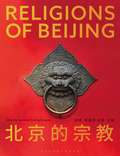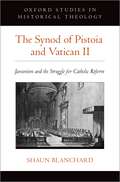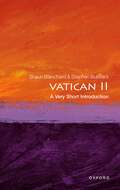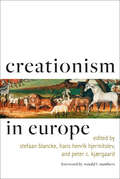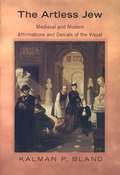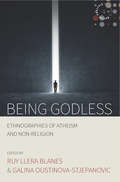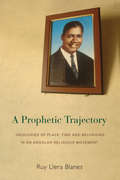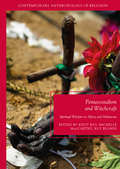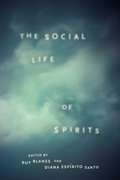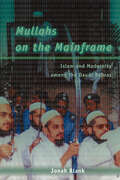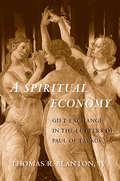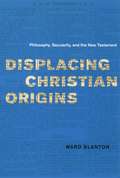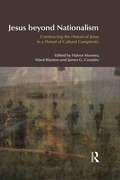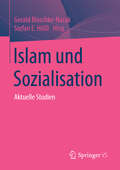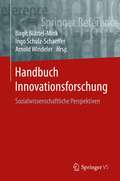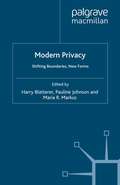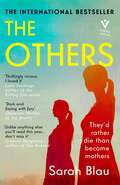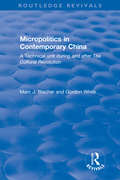- Table View
- List View
Religions of Beijing
by Bob BlanchardReligions of Beijing offers an intimate portrayal of lived religion in 17 different religious communities in greater Beijing. Students at Minzu University of China spent one year immersed in the routine and practices daily, “writing with” the experiences and perspectives of their practitioners. Each chapter has been translated into English, with students at Drake University (Des Moines, Iowa) facilitating this process. The result is a bi-lingual book (Mandarin, English) that reveals to Chinese- and English-speaking readers the vibrant diversity of lived religion in contemporary Beijing.Each chapter focuses on the histories, practices, spaces, and members of its community, telling the overall story of the renewed flourishing of religion in Beijing. The book is also enriched with over 100 photos that portray this flourishing renewal, capturing the lived experience of ordinary practitioners. Together, the words and photographs of Religions of Beijing draw the reader into the stories and lives of these communities and their members, providing a first-hand look at the contemporary practice of religion in greater Beijing. The religions covered are Buddhism, Daoism, Confucianism, Protestantism, Catholicism, Islam and folk religion.Religions of Beijing is a collaboration of Minzu University of China and Drake University, USA.
The Synod of Pistoia and Vatican II: Jansenism and the Struggle for Catholic Reform (Oxford Studies in Historical Theology)
by Shaun BlanchardIn this book, Shaun Blanchard argues that the roots of the Vatican II reforms must be pushed back beyond the widely acknowledged twentieth-century forerunners of the Council, beyond Newman and the Tübingen School in the nineteenth century, to the eighteenth century, when a variety of reform movements attempted ressourcement and aggiornamento. This close study of the Synod of Pistoia (1786) sheds surprising new light on the nature of church reform and the roots of the Second Vatican Council (1962-65). The high-water mark of the late Jansenist reform movement, this Tuscan diocesan synod was harshly condemned by Pope Pius VI in the Bull Auctorem fidei (1794), and in the increasingly ultramontane nineteenth-century Church the late Jansenist movement was totally discredited. Nevertheless, much of the Pistoian agenda--an exaltation of the role of the local bishop, an emphasis on infallibility as a gift to the entire believing community, religious liberty, a more comprehensible liturgy that incorporates the vernacular, and the encouragement of lay Bible reading and Christocentric devotions--would be officially promulgated at Vatican II. Investigating the theological and historical context and nature of the reforms enacted by the Synod of Pistoia, he notes their parallels with the reforms of Vatican II, and argues that these connections are deeper than mere affinity. The tumultuous events surrounding the reception of the Synod explain why these reforms failed at the time. This book also offers a measured theological judgment on whether the Synod of Pistoia was "true or false reform." Although the Pistoians were completely rejected in their own day, the Second Vatican Council struggled with, and ultimately enacted, remarkably similar ideas.
The Synod of Pistoia and Vatican II: Jansenism and the Struggle for Catholic Reform (Oxford Studies in Historical Theology)
by Shaun BlanchardIn this book, Shaun Blanchard argues that the roots of the Vatican II reforms must be pushed back beyond the widely acknowledged twentieth-century forerunners of the Council, beyond Newman and the Tübingen School in the nineteenth century, to the eighteenth century, when a variety of reform movements attempted ressourcement and aggiornamento. This close study of the Synod of Pistoia (1786) sheds surprising new light on the nature of church reform and the roots of the Second Vatican Council (1962-65). The high-water mark of the late Jansenist reform movement, this Tuscan diocesan synod was harshly condemned by Pope Pius VI in the Bull Auctorem fidei (1794), and in the increasingly ultramontane nineteenth-century Church the late Jansenist movement was totally discredited. Nevertheless, much of the Pistoian agenda--an exaltation of the role of the local bishop, an emphasis on infallibility as a gift to the entire believing community, religious liberty, a more comprehensible liturgy that incorporates the vernacular, and the encouragement of lay Bible reading and Christocentric devotions--would be officially promulgated at Vatican II. Investigating the theological and historical context and nature of the reforms enacted by the Synod of Pistoia, he notes their parallels with the reforms of Vatican II, and argues that these connections are deeper than mere affinity. The tumultuous events surrounding the reception of the Synod explain why these reforms failed at the time. This book also offers a measured theological judgment on whether the Synod of Pistoia was "true or false reform." Although the Pistoians were completely rejected in their own day, the Second Vatican Council struggled with, and ultimately enacted, remarkably similar ideas.
Vatican II: A Very Short Introduction (Very Short Introductions)
by Shaun Blanchard Stephen BullivantVery Short Introductions: Brilliant, Sharp, Inspiring The Second Vatican Council (1962-1965), or Vatican II, is arguably the most significant event in the life of the Catholic Church since the Reformation. The Council initiated, intentionally or not, profound changes not simply within Catholic theology, but in the religious, social, and moral lives of the world's billion Catholics. It also reconfigured, intellectually and practically, the Church's engagements with those outside of it - most obviously with regard to other religions. The sixteen documents formally issued by Vatican II constitute some of the most influential writings of the whole twentieth century. Debates over their correct interpretation and authority are constant, but they remain an indispensable point-of-reference for all areas of Catholic life, from liturgy and sacraments, to the Church's vast network of charitable and educational endeavours the world over. In this Very Short Introduction, Shaun Blanchard and Stephen Bullivant present the backstory to this event. Vatican II is explored in light of the wider history of the Catholic Church and placed in the tumultuous context of the 1960s. It distils the research on Vatican II, employing the first-hand accounts of participants and observers, and the official proceedings of the Council to paint a rich picture of one of the most important events of the last century. ABOUT THE SERIES: The Very Short Introductions series from Oxford University Press contains hundreds of titles in almost every subject area. These pocket-sized books are the perfect way to get ahead in a new subject quickly. Our expert authors combine facts, analysis, perspective, new ideas, and enthusiasm to make interesting and challenging topics highly readable.
Creationism in Europe (Medicine, Science, and Religion in Historical Context)
by Stefaan Blancke Hans Henrik Hjermitslev Peter C. KjærgaardFor decades, the creationist movement was primarily situated in the United States. Then, in the 1970s, American creationists found their ideas welcomed abroad, first in Australia and New Zealand, then in Korea, India, South Africa, Brazil, and elsewhere—including Europe, where creationism plays an expanding role in public debates about science policy and school curricula. In this, the first comprehensive history of creationism in Europe, leading historians, philosophers, and scientists narrate the rise of—and response to—scientific creationism, creation science, intelligent design, and organized antievolutionism in countries and religions throughout Europe.Providing a unique map of creationism in Europe, the authors chart the surprising history of creationist activities and strategies there. Over the past forty years, creationism has spread swiftly among European Catholics, Protestants, Jews, Hindus, and Muslims, even as anti-creationists sought to smother its flames. Antievolution messages gained such widespread approval, in fact, that in 2007 the Parliamentary Assembly of the Council of Europe passed a resolution advising member states to "defend and promote scientific knowledge" and "firmly oppose the teaching of creationism as a scientific discipline on an equal footing with the theory of evolution." Creationism in Europe offers a discerning introduction to the cultural history of modern Europe, the variety of worldviews in Europe, and the interplay of science and religion in a global context. It will be of interest to students and scholars in the history and philosophy of science, religious studies, and evolutionary theory, as well as policy makers and educators concerned about the spread of creationism in our time.
Creationism in Europe (Medicine, Science, and Religion in Historical Context)
by Stefaan Blancke Hans Henrik Hjermitslev Peter C. KjærgaardFor decades, the creationist movement was primarily situated in the United States. Then, in the 1970s, American creationists found their ideas welcomed abroad, first in Australia and New Zealand, then in Korea, India, South Africa, Brazil, and elsewhereâ€�including Europe, where creationism plays an expanding role in public debates about science policy and school curricula. In this, the first comprehensive history of creationism in Europe, leading historians, philosophers, and scientists narrate the rise ofâ€�and response toâ€�scientific creationism, creation science, intelligent design, and organized antievolutionism in countries and religions throughout Europe.Providing a unique map of creationism in Europe, the authors chart the surprising history of creationist activities and strategies there. Over the past forty years, creationism has spread swiftly among European Catholics, Protestants, Jews, Hindus, and Muslims, even as anti-creationists sought to smother its flames. Antievolution messages gained such widespread approval, in fact, that in 2007 the Parliamentary Assembly of the Council of Europe passed a resolution advising member states to "defend and promote scientific knowledge" and "firmly oppose the teaching of creationism as a scientific discipline on an equal footing with the theory of evolution." Creationism in Europe offers a discerning introduction to the cultural history of modern Europe, the variety of worldviews in Europe, and the interplay of science and religion in a global context. It will be of interest to students and scholars in the history and philosophy of science, religious studies, and evolutionary theory, as well as policy makers and educators concerned about the spread of creationism in our time.
The Artless Jew: Medieval and Modern Affirmations and Denials of the Visual
by Kalman P. BlandConventional wisdom holds that Judaism is indifferent or even suspiciously hostile to the visual arts due to the Second Commandment's prohibition on creating "graven images," the dictates of monotheism, and historical happenstance. This intellectual history of medieval and modern Jewish attitudes toward art and representation overturns the modern assumption of Jewish iconophobia that denies to Jewish culture a visual dimension. Kalman Bland synthesizes evidence from medieval Jewish philosophy, mysticism, poetry, biblical commentaries, travelogues, and law, concluding that premodern Jewish intellectuals held a positive, liberal understanding of the Second Commandment and did, in fact, articulate a certain Jewish aesthetic. He draws on this insight to consider modern ideas of Jewish art, revealing how they are inextricably linked to diverse notions about modern Jewish identity that are themselves entwined with arguments over Zionism, integration, and anti-Semitism. Through its use of the past to illuminate the present and its analysis of how the present informs our readings of the past, this book establishes a new assessment of Jewish aesthetic theory rooted in historical analysis. Authoritative and original in its identification of authentic Jewish traditions of painting, sculpture, and architecture, this volume will ripple the waters of several disciplines, including Jewish studies, art history, medieval and modern history, and philosophy.
Being Godless: Ethnographies of Atheism and Non-Religion (Studies in Social Analysis #1)
by Roy Llera Blanes Galina Oustinova-StjepanovicDrawing on ethnographic inquiry and the anthropological literature on doubt and atheism, this volume explores people's reluctance to pursue religion. The contributors capture the experiences of godless people and examine their perspectives on the role of religion in their personal and public lives. In doing so, the volume contributes to a critical understanding of the processes of disengagement from religion and reveals the challenges and paradoxes that godless people face.
A Prophetic Trajectory: Ideologies of Place, Time and Belonging in an Angolan Religious Movement
by Ruy Llera BlanesCombining ethnographic and historical research conducted in Angola, Portugal, and the United Kingdom, A Prophetic Trajectory tells the story of Simão Toko, the founder and leader of one of the most important contemporary Angolan religious movements. The book explains the historical, ethnic, spiritual, and identity transformations observed within the movement, and debates the politics of remembrance and heritage left behind after Toko’s passing in 1984. Ultimately, it questions the categories of prophetism and charisma, as well as the intersections between mobility, memory, and belonging in the Atlantic Lusophone sphere.
Pentecostalism and Witchcraft: Spiritual Warfare in Africa and Melanesia
by Ruy Blanes Knut Rio Michelle MaccarthyThis open access book presents fresh ethnographic work from the regions of Africa and Melanesia—where the popularity of charismatic Christianity can be linked to a revival and transformation of witchcraft. The volume demonstrates how the Holy Spirit has become an adversary to the reconfirmed presence of witches, demons, and sorcerers as manifestations of evil. We learn how this is articulated in spiritual warfare, in crusades, and in healing or witch-killing raids. The contributors highlight what happens to phenomena that people address as locally specific witchcraft or sorcery when re-molded within the universalist Pentecostal demonology, vocabulary, and confrontational methodology.
The Social Life of Spirits
by Ruy Blanes Diana Espirito SantoSpirits can be haunters, informants, possessors, and transformers of the living, but more than anything anthropologists have understood them as representations of something else—symbols that articulate facets of human experience in much the same way works of art do. The Social Life of Spirits challenges this notion. By stripping symbolism from the way we think about the spirit world, the contributors of this book uncover a livelier, more diverse environment of entities—with their own histories, motivations, and social interactions—providing a new understanding of spirits not as symbols, but as agents. The contributors tour the spiritual globe—the globe of nonthings—in essays on topics ranging from the Holy Ghost in southern Africa to spirits of the “people of the streets” in Rio de Janeiro to dragons and magic in Britain. Avoiding a reliance on religion and belief systems to explain the significance of spirits, they reimagine spirits in a rich network of social trajectories, ultimately arguing for a new ontological ground upon which to examine the intangible world and its interactions with the tangible one.
The Social Life of Spirits
by Ruy Blanes Diana Espírito SantoSpirits can be haunters, informants, possessors, and transformers of the living, but more than anything anthropologists have understood them as representations of something else—symbols that articulate facets of human experience in much the same way works of art do. The Social Life of Spirits challenges this notion. By stripping symbolism from the way we think about the spirit world, the contributors of this book uncover a livelier, more diverse environment of entities—with their own histories, motivations, and social interactions—providing a new understanding of spirits not as symbols, but as agents. The contributors tour the spiritual globe—the globe of nonthings—in essays on topics ranging from the Holy Ghost in southern Africa to spirits of the “people of the streets” in Rio de Janeiro to dragons and magic in Britain. Avoiding a reliance on religion and belief systems to explain the significance of spirits, they reimagine spirits in a rich network of social trajectories, ultimately arguing for a new ontological ground upon which to examine the intangible world and its interactions with the tangible one.
The Social Life of Spirits
by Ruy Blanes Diana Espirito SantoSpirits can be haunters, informants, possessors, and transformers of the living, but more than anything anthropologists have understood them as representations of something else—symbols that articulate facets of human experience in much the same way works of art do. The Social Life of Spirits challenges this notion. By stripping symbolism from the way we think about the spirit world, the contributors of this book uncover a livelier, more diverse environment of entities—with their own histories, motivations, and social interactions—providing a new understanding of spirits not as symbols, but as agents. The contributors tour the spiritual globe—the globe of nonthings—in essays on topics ranging from the Holy Ghost in southern Africa to spirits of the “people of the streets” in Rio de Janeiro to dragons and magic in Britain. Avoiding a reliance on religion and belief systems to explain the significance of spirits, they reimagine spirits in a rich network of social trajectories, ultimately arguing for a new ontological ground upon which to examine the intangible world and its interactions with the tangible one.
Mullahs on the Mainframe: Islam and Modernity among the Daudi Bohras
by Jonah BlankIn Jonah Blank's important, myth-shattering book, the West gets its first look at the Daudi Bohras, a unique Muslim denomination who have found the core of their religious beliefs largely compatible with modern ideology. Combining orthodox Muslim prayer, dress, and practice with secular education, relative gender equality, and Internet use, this community serves as a surprising reminder that the central values of "modernity" are hardly limited to the West.
A Spiritual Economy: Gift Exchange in the Letters of Paul of Tarsus (Synkrisis)
by Thomas R. Blanton IVThomas Blanton sheds light on the philosophy surrounding gift giving in Paul’s letters and on modern theories of gift exchange through the lens of religion. The exchange of gifts is a fundamental part of society and a foundational element in Greco-Roman religions. Combining theories of gift exchange, both modern and Greco-Roman, Thomas Blanton reveals how religious discourse—in the guise of “spiritual gifts” believed to come from Israel’s god—is instrumental in the formation of sociopolitical hierarchies and the assignment of honor and prestige. Blanton uses an interdisciplinary approach that incorporates religion, classics, sociology, and anthropology to investigate the economy of gift exchange shown in Paul’s letters.
Displacing Christian Origins: Philosophy, Secularity, and the New Testament (Religion and Postmodernism)
by Ward BlantonRecent critical theory is curiously preoccupied with the metaphors and ideas of early Christianity, especially the religion of Paul. The haunting of secular thought by the very religion it seeks to overcome may seem surprising at first, but Ward Blanton argues that this recent return by theorists to the resources of early Christianity has precedent in modern and ostensibly secularizing philosophy, from Kant to Heidegger. Displacing Christian Origins traces the current critical engagement of Agamben, Derrida, and Žižek, among others, back into nineteenth- and early-twentieth-century philosophers of early Christianity. By comparing these crucial moments in the modern history of philosophy with exemplars of modern biblical scholarship—David Friedrich Strauss, Adolf Deissmann, and Albert Schweitzer—Blanton offers a new way for critical theory to construe the relationship between the modern past and the biblical traditions to which we seem to be drawn once again. An innovative contribution to the intellectual history of biblical exegesis, Displacing Christian Origins will promote informed and fruitful debate between religion and philosophy.
Displacing Christian Origins: Philosophy, Secularity, and the New Testament (Religion and Postmodernism)
by Ward BlantonRecent critical theory is curiously preoccupied with the metaphors and ideas of early Christianity, especially the religion of Paul. The haunting of secular thought by the very religion it seeks to overcome may seem surprising at first, but Ward Blanton argues that this recent return by theorists to the resources of early Christianity has precedent in modern and ostensibly secularizing philosophy, from Kant to Heidegger. Displacing Christian Origins traces the current critical engagement of Agamben, Derrida, and Žižek, among others, back into nineteenth- and early-twentieth-century philosophers of early Christianity. By comparing these crucial moments in the modern history of philosophy with exemplars of modern biblical scholarship—David Friedrich Strauss, Adolf Deissmann, and Albert Schweitzer—Blanton offers a new way for critical theory to construe the relationship between the modern past and the biblical traditions to which we seem to be drawn once again. An innovative contribution to the intellectual history of biblical exegesis, Displacing Christian Origins will promote informed and fruitful debate between religion and philosophy.
Displacing Christian Origins: Philosophy, Secularity, and the New Testament (Religion and Postmodernism)
by Ward BlantonRecent critical theory is curiously preoccupied with the metaphors and ideas of early Christianity, especially the religion of Paul. The haunting of secular thought by the very religion it seeks to overcome may seem surprising at first, but Ward Blanton argues that this recent return by theorists to the resources of early Christianity has precedent in modern and ostensibly secularizing philosophy, from Kant to Heidegger. Displacing Christian Origins traces the current critical engagement of Agamben, Derrida, and Žižek, among others, back into nineteenth- and early-twentieth-century philosophers of early Christianity. By comparing these crucial moments in the modern history of philosophy with exemplars of modern biblical scholarship—David Friedrich Strauss, Adolf Deissmann, and Albert Schweitzer—Blanton offers a new way for critical theory to construe the relationship between the modern past and the biblical traditions to which we seem to be drawn once again. An innovative contribution to the intellectual history of biblical exegesis, Displacing Christian Origins will promote informed and fruitful debate between religion and philosophy.
Jesus Beyond Nationalism: Constructing the Historical Jesus in a Period of Cultural Complexity (BibleWorld)
by Ward Blanton James G. Crossley Halvor MoxnesThe study of Jesus has rarely looked at its own scholarly context, at how the representation of Jesus might be shaped by those who study him. 'Jesus beyond Nationalism' examines how - since the beginnings of historical Jesus studies in the nineteenth century - representations of Jesus have been used to promote hegemonic or mono-cultural views. The ideology behind such representation has operated to deny difference in society, difference in terms of race, ethnicity, gender, and sexuality. Examining depictions of Jesus in a range of contexts - from the Russian Christ and Jesus as 'Holy Anarchist' to Jesus in Muslim thought - Jesus Beyond Nationalism reveals the politics behind the ways in which Jesus has been constructed and presented.
Jesus Beyond Nationalism: Constructing the Historical Jesus in a Period of Cultural Complexity (BibleWorld)
by Ward Blanton James G. Crossley Halvor MoxnesThe study of Jesus has rarely looked at its own scholarly context, at how the representation of Jesus might be shaped by those who study him. 'Jesus beyond Nationalism' examines how - since the beginnings of historical Jesus studies in the nineteenth century - representations of Jesus have been used to promote hegemonic or mono-cultural views. The ideology behind such representation has operated to deny difference in society, difference in terms of race, ethnicity, gender, and sexuality. Examining depictions of Jesus in a range of contexts - from the Russian Christ and Jesus as 'Holy Anarchist' to Jesus in Muslim thought - Jesus Beyond Nationalism reveals the politics behind the ways in which Jesus has been constructed and presented.
Islam und Sozialisation: Aktuelle Studien
by Gerald Blaschke-Nacak Stefan HößlDer Band leistet einen differenzierten Beitrag zur Frage nach Verhältnisbestimmungen von Islam und Sozialisation, indem er Einblicke in qualitativ ausgerichtete Forschungsarbeiten bietet, die der Frage nach der Bedeutung islamischer Religiosität für das Aufwachsen bzw. das ‚Sein in der Welt‘ nachgehen. Die Beiträge richten die Aufmerksamkeit u.a. auf Prozesse der Adressierung und Kategorisierung, Bedeutungsdimensionen der Anerkennung, bildungsbezogene Praktiken und deren biographische Bedeutung, moralische Orientierungen und ästhetische Rezeptionsformen sowie geschlechtsbezogene Rollenverständnisse im Zusammenhang mit islamischer Religiosität.
Handbuch Innovationsforschung: Sozialwissenschaftliche Perspektiven
by Birgit Blättel-Mink Ingo Schulz-Schaeffer Arnold WindelerDas Handbuch erörtert umfassend das komplexe Gebiet der sozialwissenschaftlichen Innovationsforschung. Es ordnet die Innovationsforschung geschichtlich, begrifflich und vom Gegenstand her ein. Es präsentiert etablierte und sich neu herausbildende theoretische Ansätze der sozialwissenschaftlichen Innovationsforschung. Und es informiert über empirische Befunde und Entwicklungen aus einer Vielzahl von Bereichen und Feldern der Innovation.
Modern Privacy: Shifting Boundaries, New Forms
by Harry Blatterer Pauline Johnson Maria R. MarkusModern Privacies addresses emergent transformations of privacy in western societies from a multidisciplinary and international perspective. It examines social and cultural trends in new media, feminism, law, work and intimacy which indicate that our perceptions, evaluations and enactments of privacy in constant flux.
The Others: They would rather die than be mothers in this page-turning thriller
by Sarah BlauThe timely and controversial Israeli bestseller about four women and their fatal promise not to have childrenThey would rather die than become mothersA serial killer is on the loose in Tel Aviv. Each victim is found tied to a chair with a baby doll glued to their hands, the word ‘mother’ carved into their foreheads like a mark of Cain.Stowed away between the wax figurines of the Bible museum where she works, Sheila Heller suspects that she alone knows the connection between the victims. The killings seem to be linked by a pact their group all made at university – to never have children.What Sheila doesn’t know is who is committing these gruesome acts of ritualistic violence, and whether she herself might be the next target.Sarah Blau is an author and playwright, recipient of the 2015 Prime Minister’s Prize for Hebrew Literature and the 2017 Bar-Ilan University Alumni Achievement Award in recognition of her contribution to enriching culture in Israel. She currently lives in Tel Aviv and The Others is her fourth novel but the first to be translated into English.
Micropolitics in Contemporary China (Routledge Revivals)
by Marc J. Blecher Gordon WhiteThis title was first published in 1980. One of the most prevalent and significant issues facing socialist countries is the role of intellectuals. In the poorer countries like China, this has presented itself with particular acuity in the relationship of scientists and technicians to the process of socialist economic modernization. Since the Cultural Revolution has come to a close, its impact on China’s intellectual life— especially on scientists, technicians, and the development of scientific and technical work— has been the subject of lively inquiry in China. In turn, this inquiry has provided a major focus for reevaluating the Cultural Revolution as a political movement and as a way of dealing with the inequalities and bureaucratic inefficiencies that have arisen and will continue to arise in the centrally planned Chinese economy during a period when rapid economic growth and modernization have been given the highest priority. This monograph intends to address some of these issues by presenting a detailed case study of a Chinese technical unit over the period from 1966 to 1974.
